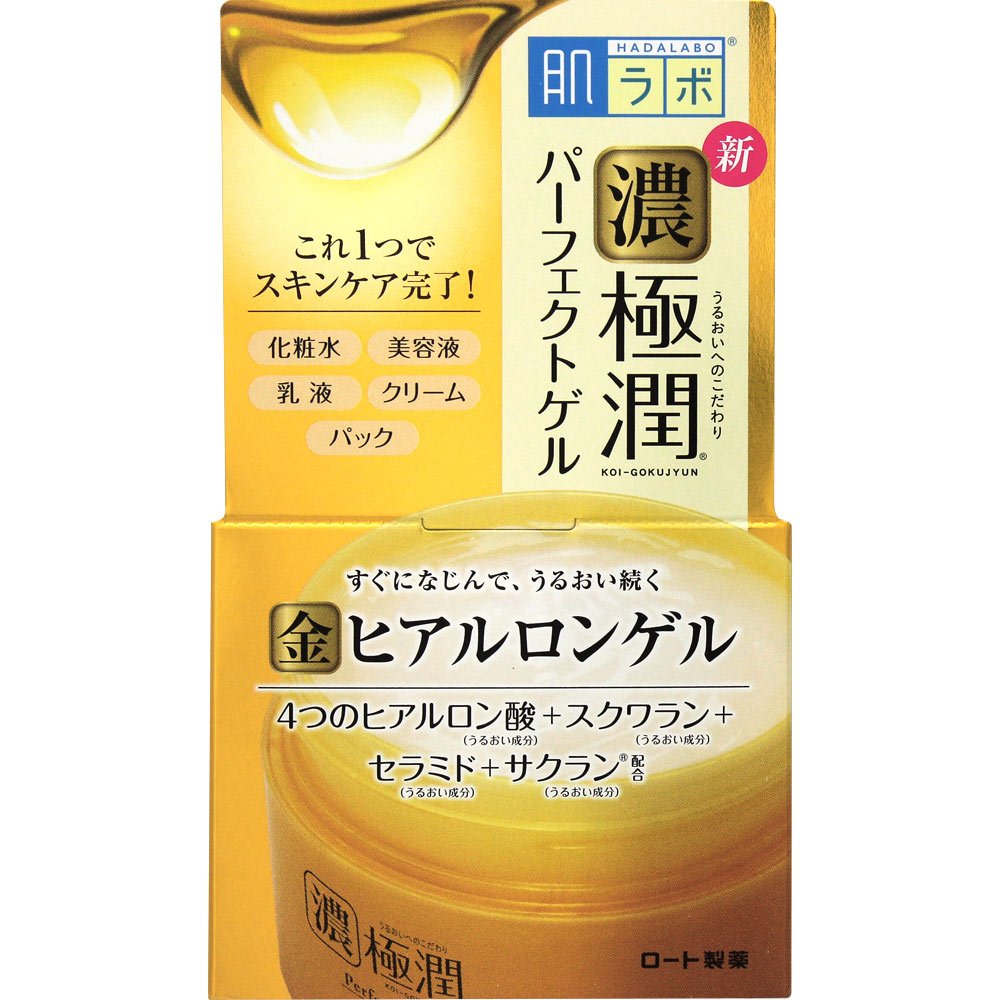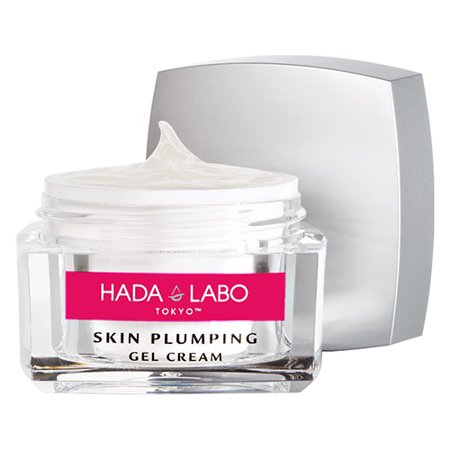

Hada Labo
Gokujyun Perfect Gel
Uploaded on 06/19/2019
Rich and thick gel moisturizes your deeper skin and seals
in moisture. Makes your skin soft, shiny and resilient
Hada Labo
Skin Plumping Gel Cream
Uploaded on 07/23/2018
This luxurious silky gel cream combines the skin perfecting power
of a serum with the intense hydration of a moisturizer.
Ingredients
| what‑it‑does | solvent |
Normal (well kind of - it's purified and deionized) water. Usually the main solvent in cosmetic products.
[more]
| what‑it‑does | moisturizer/humectant |
A derivative of Urea, that works as a strong moisturizer and humectant meaning that it helps the skin to cling onto water and thus to make it hydrated and elastic.
According to manufacturer's data, Hydroxyethyl Urea has a similar moisturizing ability to glycerin (measured at 5%), but it feels nicer on the skin as it is non-sticky and non-tacky and gives a lubri
[more]
| what‑it‑does | moisturizer/humectant | solvent |
| irritancy, com. | 0, 1 |
An often used glycol that works as a solvent, humectant, penetration enhancer and also gives a good slip to the products.
[more]
| what‑it‑does | skin-identical ingredient | moisturizer/humectant |
| irritancy, com. | 0, 0 |
A real oldie but a goodie. Great natural moisturizer and skin-identical ingredient that plays an important role in skin hydration and general skin health.
[more]
| what‑it‑does | solvent | moisturizer/humectant |
A multi-functional, silky feeling helper ingredient that can do quite many things. It's used as an emulsion stabilizer, solvent, and a broad spectrum antimicrobial.
[more]
| what‑it‑does | moisturizer/humectant |
A glycerin derived, synthetic oily liquid that is also water soluble and works as a great skin moisturizer.
[more]
| what‑it‑does | skin-identical ingredient | emollient |
| irritancy, com. | 0, 1 |
An emollient and natural moisturizer that can be found also in the sebum (oily stuff our skin produces). It leaves a nice non-greasy, non-heavy feeling on the skin.
[more]
| what‑it‑does | emollient | perfuming |
A colorless to pale yellow liquid ester that makes the skin nice and smooth, aka emollient. It has a pleasant non-sticky, non-greasy feel to it and gives formulas smooth application properties.
| what‑it‑does | viscosity controlling |
A kind of polymer (big molecule from repeated subunits) that helps to create beautiful gel-like textures. It's also a texturizer and thickener for oil-in-water emulsions.
[more]
| what‑it‑does | viscosity controlling |
| what‑it‑does | moisturizer/humectant |
| what‑it‑does | skin-identical ingredient |
An amino acid that is one of the primary building blocks of hair keratin and skin collagen. It's a natural moisturizing factor and might also help to speed up wound healing.
[more]
| what‑it‑does | buffering |
An AHA that comes from citrus fruits. It is usually used as a helper ingredient to adjust the pH of the formula.
[more]
| what‑it‑does | emollient |
| irritancy, com. | 0, 1 |
A very common silicone that gives both skin and hair a silky smooth feel. It also forms a protective barrier on the skin and fills in fine lines. Also used for scar treatment.
[more]
| what‑it‑does | solvent |
A clear, colorless liquid that works as a solvent and viscosity decreasing ingredient. It also has great skin-moisturizing abilities.
[more]
| what‑it‑does | chelating |
Super common little helper ingredient that helps products to remain nice and stable for a longer time. It does so by neutralizing the metal ions in the formula (that usually get into there from water) that would otherwise cause some not so nice changes.
[more]
| what‑it‑does | emollient | moisturizer/humectant |
The chemically chopped up version of the big protein molecule, collagen. It is often derived from fish or bovine sources and works as a nice moisturizer and humectant that helps the skin to hold onto water.
To understand a bit more what Hydrolyzed Collagen is, you have to know that proteins are large chains of amino acids connected with so-called peptide bonds.
[more]
| what‑it‑does | moisturizer/humectant |
Hydrolyzed Hyaluronic Acid is a low molecular weight, chemically chopped up version of the naturally big molecule and current IT-moisturizer, Hyaluronic Acid (HA). The TL;
[more]
| what‑it‑does | preservative |
It's one of those things that help your cosmetics not to go wrong too soon, aka a preservative. Its strong point is being effective against yeasts and molds, and as a nice bonus seems to be non-comedogenic as well.It is safe in concentrations of less than 0.1% but is acutely toxic when inhaled, so it's not the proper preservative choice for aerosol formulas like hairsprays.
[more]
| what‑it‑does | preservative |
Preservative with relatively high irritation risk that is used mainly in rinse-off products.
[more]
| what‑it‑does | moisturizer/humectant |
Sodium Acetylated Hyaluronate is a variation of current IT moisturizer, Hyaluronic acid, where some water-loving -OH groups are replaced by amphipathic (partly water-loving and partly water-hating) acetyl groups.
[more]
| what‑it‑does | viscosity controlling |
Sodium chloride is the fancy name of salt. Normal, everyday table salt.
If (similar to us) you are in the weird habit of reading the label on your shower gel while taking a shower, you might have noticed that sodium chloride is almost always on the ingredient list.
[more]
| what‑it‑does | chelating | buffering |
A helper ingredient that is used to adjust the pH of the product. Also helps to keep products stay nice longer by neutralizing the metal ions in the formula.
| what‑it‑does | skin-identical ingredient | moisturizer/humectant |
| irritancy, com. | 0, 0 |
It's the salt form of famous humectant and natural moisturizing factor, hyaluronic acid. It can bind huge amounts of water and it's pretty much the current IT-moisturizer.
[more]
| what‑it‑does | perfuming |
| what‑it‑does | moisturizer/humectant | emollient |
A sugar derived liquid that works as a water-soluble emollient (makes your skin nice and smooth), fragrance fixative and humectant (helps skin to hold onto water) on the skin.
[more]
| what‑it‑does | skin-identical ingredient | antioxidant | emollient |
Squalene is an oily liquid that originally comes from shark liver but luckily it can also be found in a couple of plant oils. Olive (0.6%), peanut (0.1%) and pumpkin (0.35%) oils contain it, though not in huge amounts. What contains more of it, is the sebum (the oily stuff) that our skin produces.
[more]
| what‑it‑does | emollient | viscosity controlling |
A fatty alcohol (the non-drying type) that is used to increase the viscosity of the formula and stabilize emulsions.
[more]
| what‑it‑does | viscosity controlling |
| what‑it‑does | emollient | solvent |
It's a super commonly used water-thin volatile silicone that gives skin and hair a silky, smooth feel.
[more]
| what‑it‑does | preservative |
Pretty much the current IT-preservative. It’s safe and gentle, and can be used up to 1% worldwide.
[more]
| what‑it‑does | surfactant/cleansing |
| what‑it‑does | viscosity controlling |
A high-molecular-weight silicone elastomer (rubber-like elastic material) that is usually blended with a base silicone fluid (such as dimethicone or cyclopentasiloxane) to give the formula a silky smooth feel and to act as a thickening agent.
[more]
| what‑it‑does | buffering |
| what‑it‑does | viscosity controlling |
| what‑it‑does | preservative |
| irritancy, com. | 0, 0 |
The most common type of feared-by-everyone-mostly-without-scientific-reason parabens. It's a cheap, effective and well-tolerated ingredient to make sure the cosmetic formula does not go wrong too soon.
Apart from the general controversy around parabens (we wrote about it more here), there is a 2006 in-vitro (made in the lab not on real people) research about methylparaben (MP) sho
[more]





